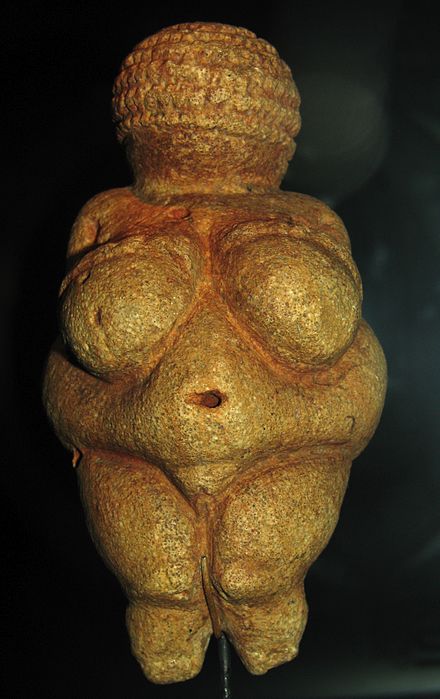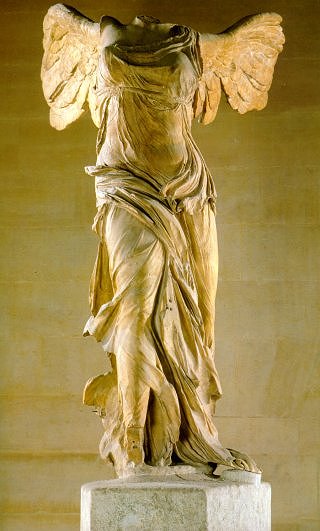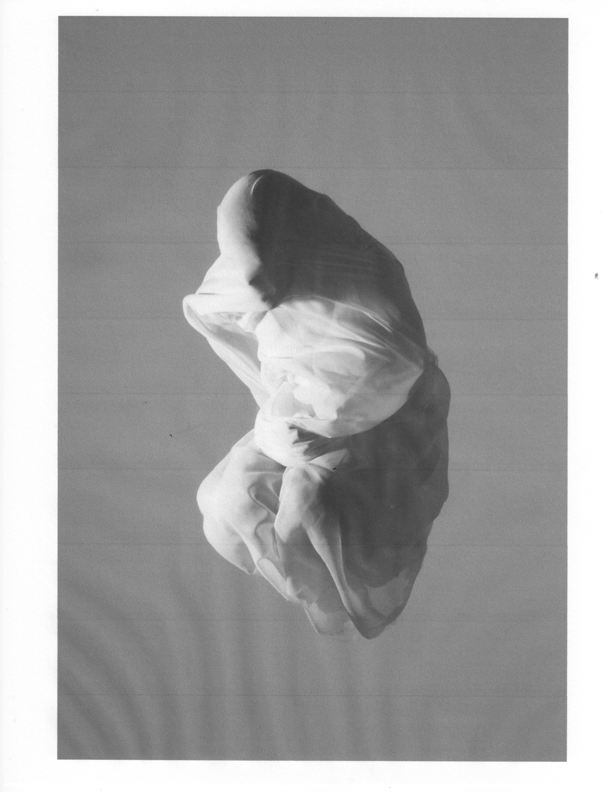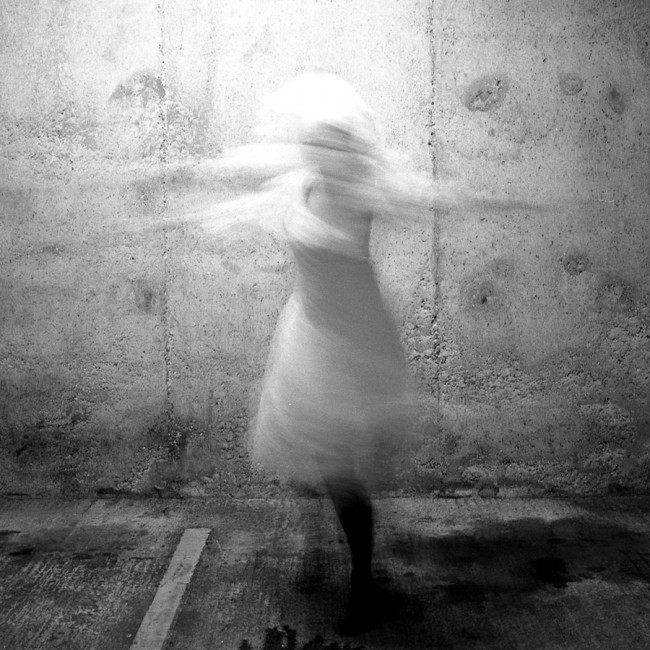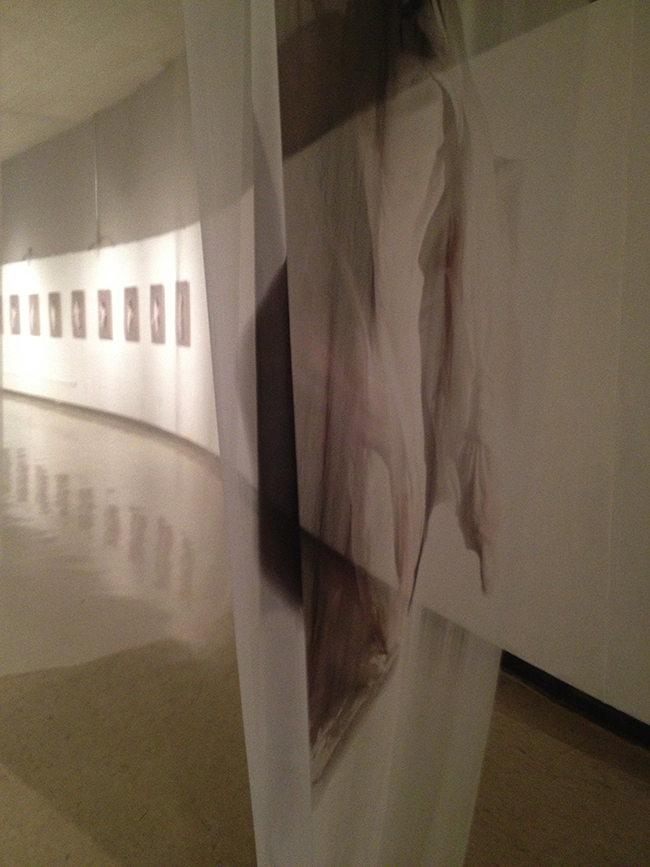by Christine Huskisson
Nearly fifteen panels of translucent silk hung at the entrance of the Tuska Gallery for Contemporary Art on the campus of the University of Kentucky. They overlapped in such a way as to block any clear access to the interior of the gallery space that housed the B.F.A. exhibition of Roya Ramezankhani during May of 2014.
Each panel was approximately five feet wide by twenty-five feet in length – falling ceiling to floor and attached by a delicate framework at the topmost side. They were imprinted with a single form bound by masses of the same soft, white material, which draped sensually over some of the forms and confined others.
Inside each of these images was something distinctly female, possibly an image of the artist, who is a recent graduate of The School for the Visual Arts and Studies at the University of Kentucky. But, it is important to note that these images are not self-portraits alone; they are far more insightful, recalling mythical and religious narratives of the female archetype throughout history.
As I made my way through this installation of hanging fabric, I saw things that I did not quite expect. Some of the figures remained silent as if they were protecting something sacred. Was the artist inspired by one of the oldest images of the female form, that of the Venus (or Woman) of Willendorf from the Paleolithic Age? Another silken image brushed against me as though searching for some invisible force like the wind that made tangible the female form of the Nike of Samothrace.
Jolted into motion by a fellow observer, a third image turned away from me, her form appearing and disappearing as though struggling to free herself from the confines of the artist’s chosen medium. It made me think of the Three Goddesses whose figures were visibly bound within the east pediment of the Parthenon.
I stopped in the middle of this hanging installation to ponder what little I knew of this young artist, mostly from her artist’s statement. I knew that Roya Ramezankhani was born in Lexington, Kentucky to an Iranian-American family. I knew, too, that she was interested in exploring those things that separate us from each other, from ourselves, and from the world around us – whether physical or mythical. Beyond this veiling, I could see the public space where Ramezankhani would perform that evening. It was a circle delineated by broken, purple thread.
Just before entering that space, one last hanging image struck me. It was undoubtedly an image of the artist bound tightly into the fetal position, material stretched over her open mouth as though she were in that suffocating moment just before the touch of God in the Creation of Adam by Michelangelo on the ceiling of the Sistine Chapel of The Vatican.
It was then that I realized these hanging images, through which everyone had to pass to experience Exhale in its entirety, were heralds proclaiming something unique: Was it to challenge the myth of female archetypes? Was it the creation of an alternative universe where male origin stories are retold from the female point of view? The ring of thread – as opposed to the ring of fire – made me even wonder if it was to link the birth of this artist with that of creation itself? Her performance solidified that thought.
The artist and another woman emerged from behind a video of beautiful fabric moving as delicately as a dropped sheet onto a bed. Dark colored thread then unraveled falling from the top of the video image to the bottom. The performers stepped into a circle of thread. They both adopted a fetal position and remained quiet for what seemed too long.
Ramezankhani then came to life in fits and starts, skin squeaking across the cold linoleum floor. Audible breaths of sigh and relief empowered her. After repeatedly slumping and rising from the floor, she reached an upright position and fell again. At this moment, the second female figure came to life, struggling and assisting Ramezankhani at the same time. Awkwardly to two figures, dependent upon one another, stood held onto each other and exited the circle of thread.
It seems that this artist has taken the time needed to examine her place as a woman and as a woman artist. She seems aware of important precedents in the history of body and performance art, particularly as they were influenced by the feminist movement. She employs techniques from artists like Francesca Woodman (1972-1980), who presented a more challenging image of the female form than that historically produced and consumed for the male gaze.
Ramezankhani’s imagery recalls the surreal nature and intimate experience of works by Woodman, but she does not use photography and video to blur or whitewash. Instead Ramezankhani seems committed to combining an array of media including installation, dance and video to revive something new.
For me, Ramezankhani’s statement here is powerful. After referencing historical, mythical, and religious archetypal narratives, the Woodman influence becomes far more poignant. Could she be considering the untimely death of Woodman as the end of such storytelling; that Woodman’s life and death are now a part of a postmodern narrative on the birth of something new?
In fact, there is an image that I shot while at the show that is wildly different from most of Ramezankhani’s imagery. It is no doubt just the position of the fabric or of my camera, but I could not help but think that it was the spirit or soul of Woodman, in what may only be one of her many posthumous statements. Here, the female form is gone from this image, gone perhaps so that something else might live.
Ramezankhani relies on the use postmodern narrative as there is no longer room to tell stories of her direct experiences. Rather, she turns to the world is an amalgam of vaguely remembered fictions about the past, all the while understanding her present, because it is only in the post-1970s moment that she is able to reintroduce narrative with this particular pastiche.
Exhale
Roya Ramezankhani
B.F.A Solo Exhibition
May, 2014
Tuska Center for Contemporary Art
Fine Arts Building
University of Kentucky
465 Rose Street, Lexington, Kentucky


